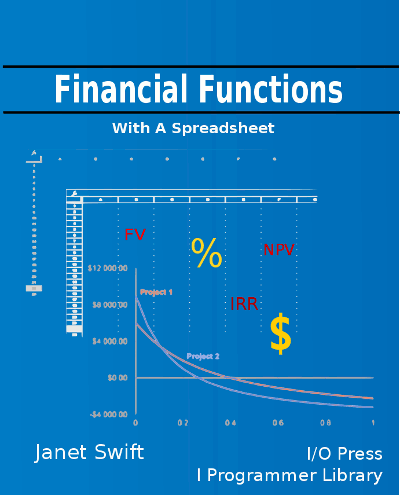| Present and Future Values |
| Written by Janet Swift | |||||||
Page 1 of 6 The principles of present and future value apply even if the cash flow is irregular. The calculations are just a matter of breaking down the cashflow calculations into simple steps.
Financial Functions
Buy from AmazonSpreadsheets take the hard work out of calculations, but you still need to know how to do them. Financial Functions with a spreadsheet is all about understanding and reasoning, using a spreadsheet to do the actual calculation.
<ASIN:1871962013> <ASIN:B07S79ZVMQ> Chapter SevenIn earlier chapters we have examined how money behaves under some particularly simple situations - a single deposit or loan accruing interest and the effect of a regular cashflow on the same. In real life cashflows are often irregular both in time and in amount. This makes it difficult to evaluate the worth of an investment or the cost of a loan that involves irregular payments. However all is not lost because there are a range of methods that can be used to compare such investments and loans. In this and the next chapter we examine the ideas of the present and future value of money and see how these ideas can be used to make judgements about the worth of an investment. The time value of moneyThe most important thing to realise when evaluating an investment is that money now is worth more than money in the future - even if you ignore the action of inflation. The reason is that money that you have now can be invested and can earn a safe rate of interest. If you are deprived of a sum of money until a later date then you have to take into account the loss of interest. You can think of this as an opportunity cost of not having the money. If the prevailing ‘no risk’ interest rate is I% then $PV will grow to $FV given by:
in n time periods. The present value grows into the future value by the action of compound interest. This relationship can be turned the other way about and we can say that the future value can be discounted back to its equivalent present value. This relationship between Future Value and Present Value is fundamental to the measurement of the time value of money. If you are to receive a sum of money in the future then what ever it is worth then it is only worth the equivalent present value now. That is, all Future Values should be reduced to their corresponding Present Values before their worth can be assessed using:
You can think of this as reducing future sums of money by a discount factor of 1/(1+I)^n to allow for the effect of interest. For example, if you are to receive $100 in 5 years time, i.e. FV=500 and n=5*12, the Present Value is: PV=500/(1+0.08/12)^(5*12)=355.60 So if you were offered $500 in 5 years time or $355.60 now there would be no reason to prefer one or the other on purely financial grounds. It is in this sense that the present value and the future value represent the same amount of wealth - one will become the other by the action of time and interest. The safe interest rateOf course the equivalence of FV and PV does depend on the interest rate that you choose to use in the formula and this adds a degree of arbitrariness into the comparison. In practice you should use an interest rate that makes the comparison meaningful to you. For example, there is no point in using an interest rate that is not accessible to you or to the sum of money under consideration. So using a high rate that can only be obtained by large deposits isn’t reasonable in most cases, neither is a high risk rate. You should in general choose an interest rate that is readily obtainable and regarded as a safe investment. There is another problem in that safe interest rates may vary over the period of the calculation and so alter the present value. However factors that alter the ‘safe’ interest rate also tend to affect the return on every type of investment and so the alter the future value in the same way as the present value! As a result the present value still provides an excellent way of comparing different investment opportunities. |
